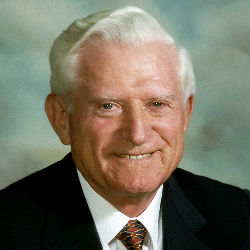
American computer architect and high-tech entrepreneur Gene Myron Amdahl died recently at the age of 92.
Amdahl’s wife Marian said he had suffered from Alzheimer’s disease for about five years, before succumbing to pneumonia. “We are thankful for his kind spirit and brilliant mind. He was a devout Christian and a loving father and husband. I was blessed with having him as my husband and my best friend.”
Born in South Dakota, Amdahl served in the U.S. Navy during World War II. He completed a bachelor’s degree in engineering physics at South Dakota State University in 1948 and went on to study theoretical physics at the University of Wisconsin-Madison, where he received his doctorate in 1952.
Amdahl joined IBM in 1952, where he worked on the IBM 704, the IBM 709, and the Stretch project, the basis for the IBM 7030. He left IBM in 1955 but returned in 1960 and became chief architect of the System/360 mainframe computer. Amdahl was named an IBM Fellow in 1965, and head of the IBM Advanced Computing Systems Laboratory in Menlo Park, CA. He left IBM again in 1970 and set up Amdahl Corporation, which specialized in IBM mainframe-compatible computer products, with the help of Fujitsu.
The company manufactured “plug-compatible” mainframes, starting in 1975 with the Amdahl 470V/6, a less expensive, more reliable, faster alternative to IBM’s System 370/168. Amdahl’s software team developed Virtual Machine/Performance Enhancement (VM/PE) software to optimize the performance of IBM’s Multiple Virtual Storage (MVS) operating system when running under IBM’s VM operating system. Within four years, the corporation had sold more than $1 billion worth of V6 and V7 mainframes and had more than 6,000 employees worldwide.
At ACM’s Spring Joint Computer Conference in 1967, Amdahl participated in a discussion on future architectural trends, arguing for performance limitations in any special feature or mode introduced to new machines. This resulted in what came to be known as Amdahl’s Law regarding sequential vs. parallel processing.
Amdahl left his company in 1979 to set up Trilogy Systems, a company aimed at designing an integrated chip for even cheaper mainframes. When the chip development failed within months of the company’s $60 million public offering, Trilogy focused on developing its VLSI technology, which also did not do well. In 1985, Trilogy was merged into microcomputer manufacturer Elxsi (now Tata Elxsi), but poor results there had Amdahl leaving in 1989 for a company he had founded in 1987 to produce mid-sized mainframes, Andor International, which by 1995 had been driven into bankruptcy by production problems and strong competition.
In 1996, Amdahl co-founded Commercial Data Servers, again developing mainframe-like machines, but this time with super-cooled processor designs aimed at physically smaller systems. The company, Xbridge Systems, develops software to scan mainframe datasets and database tables for sensitive information such as credit card numbers, government identification numbers, and medical diagnosis information.
Amdahl was a member of the National Academy of Engineering and the recipient of honorary doctorates from four institutions. He also was the recipient of the IEEE’s Harry H. Goode Memorial Award, a Fellow of the Computer History Museum, and recipient of the ACM Special Interest Group on Design Automation (SIGDA) Pioneering Achievement Award.
Said David Patterson, a professor of computer sciences at the University of California, Berkeley, and a computer pioneer in his own right, “The IBM System/360 was one of the greatest computer architectures of all time, being both a tremendous technical success and business success. It invented a computer family, which we would call binary compatibility today. When he left to form his own company, his mainframes were binary-compatible with the System/360.”
Patterson noted Amdahl’s Law was based on a brief paper (http://bit.ly/1rUSzL7) submitted to ACM’s Spring Joint Computer Conference “basically offering a critique to enthusiasts about the parallel supercomputers of the era.” He added that Amdahl’s Law “may be obvious, but architects still keep being caught by it, seeing their hopes dashed for their cool ideas.”
In addition to Amdahl’s Law, Patterson said, “Less well-known are Amdahl’s rules of thumb for a balanced computer system,” such as “A system needs a bit of IO per second and one byte of main memory for each instruction per second.”
Software engineer, computer scientist, and 1999 ACM A.M. Turing Award recipient Fred Brooks, a colleague of Amdahl’s during his time at IBM, recalled a number of instances of Amdahl’s “architectural and implementation brilliance” that allowed his IBM 704 to “utterly dominate its chief competitor, the Univac 1103A, in the scientific computing market.”
Brooks added, “We have indeed lost one of the truly great computer designers.”




Join the Discussion (0)
Become a Member or Sign In to Post a Comment